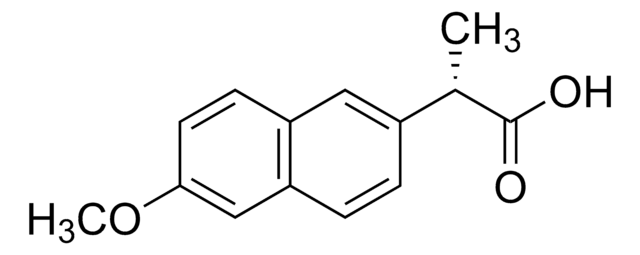1457403
USP
Naproxen sodium
United States Pharmacopeia (USP) Reference Standard
Sinônimo(s):
(S)-6-Methoxy-α-methyl-2-naphthaleneacetic acid sodium salt
About This Item
Produtos recomendados
grau
pharmaceutical primary standard
família API
naproxen
fabricante/nome comercial
USP
aplicação(ões)
pharmaceutical (small molecule)
Formato
neat
cadeia de caracteres SMILES
[Na+].COc1ccc2cc(ccc2c1)[C@H](C)C([O-])=O
InChI
1S/C14H14O3.Na/c1-9(14(15)16)10-3-4-12-8-13(17-2)6-5-11(12)7-10;/h3-9H,1-2H3,(H,15,16);/q;+1/p-1/t9-;/m0./s1
chave InChI
CDBRNDSHEYLDJV-FVGYRXGTSA-M
Informações sobre genes
human ... PTGS1(5742) , PTGS2(5743)
Procurando produtos similares? Visita Guia de comparação de produtos
Descrição geral
Aplicação
- Naproxen Sodium and Pseudoephedrine Hydrochloride Extended-Release Tablets
- Naproxen Sodium Tablets
Ações bioquímicas/fisiológicas
Nota de análise
Outras notas
produto relacionado
Palavra indicadora
Danger
Frases de perigo
Declarações de precaução
Classificações de perigo
Acute Tox. 4 Oral - Repr. 1A
Código de classe de armazenamento
6.1C - Combustible acute toxic Cat.3 / toxic compounds or compounds which causing chronic effects
Classe de risco de água (WGK)
WGK 3
Ponto de fulgor (°F)
Not applicable
Ponto de fulgor (°C)
Not applicable
Escolha uma das versões mais recentes:
Certificados de análise (COA)
Lamentamos, não temos COA para este produto disponíveis online no momento.
Se precisar de ajuda, entre em contato Atendimento ao cliente
Já possui este produto?
Encontre a documentação dos produtos que você adquiriu recentemente na biblioteca de documentos.
Nossa equipe de cientistas tem experiência em todas as áreas de pesquisa, incluindo Life Sciences, ciência de materiais, síntese química, cromatografia, química analítica e muitas outras.
Entre em contato com a assistência técnica





